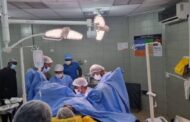Providing sufficient personal protective equipment (PPE) for healthcare workers amid the coronavirus pandemic has become a major source of debate around the world.
Western nations, such as the US and UK, as well as less-developed countries, have struggled to secure enough PPE for healthcare staff at hospitals, resulting in protests and strikes.
In the US, the Centers for Disease Control has put out detailed instructions on optimisation and contingency strategies for hospitals and healthcare workers in case of a shortage of PPE’s, including how to process reusable equipment.
Britain’s National Health Service announced earlier this week they were reversing their previous advice for healthcare workers to wear full-length waterproof surgical gowns when treating COVID-19 patients, saying they should instead use plastic aprons as PPE supplies become limited across the country.
Here is all you need to know about different types of PPE:
Face masks
According to the World Health Oganization, the use of medical face masks is “critical” and is “prioritised” for those working in healthcare settings.
One type of face-covering are surgical masks, which help prevent large droplets that may carry viruses and bacteria, from entering one’s respiratory system via the mouth or nose. The masks are loose-fitting in their design and are not sufficient in keeping out smaller particles.
N95 respirators are the most effective and sought-after masks for health workers treating COVID-19 patients. These single-use respirators are made from polyester fibres and are touted to keep out 95 percent of small airborne particles from entering.
However, the US Food and Drug Administration has cautioned against using N95 masks for people who have existing respiratory or cardiac illnesses, considering it can be hard to breathe through the respirators.
Due to shortages, governments around the world have strongly urged that N95 respirators be kept for the use of healthcare workers, not the general public.

Gowns
Protective clothing like gowns and aprons help prevent droplets and splashes from coming into contact with a health worker’s skin, providing an added layer of protection.
As per the WHO, healthcare professionals “should wear a clean, non-sterile, long-sleeved gown” and that the use of impermeable aprons or boots was not required.
However, as shortages of PPE are reported across the world, some countries are advising healthcare workers to use plastic aprons and coveralls as alternatives.
Gloves
Covering hands in dealing with COVID-19 patients is deemed essential. Gloves form a core part of PPEs that healthcare workers are advised to use when interacting with a COVID-19 patient.
Once used, they must be disposed of immediately and in proper fashion so the outer part of the glove does not touch one’s bare hand.
Goggles
Eye protection such as goggles are recommended by the WHO and the CDC when dealing with coronavirus cases to protect healthcare workers from splatters or splashes of droplets.
Visors integrated with face masks can also be used to protect the eyes.
SOURCE: AL JAZEERA NEWS




















































